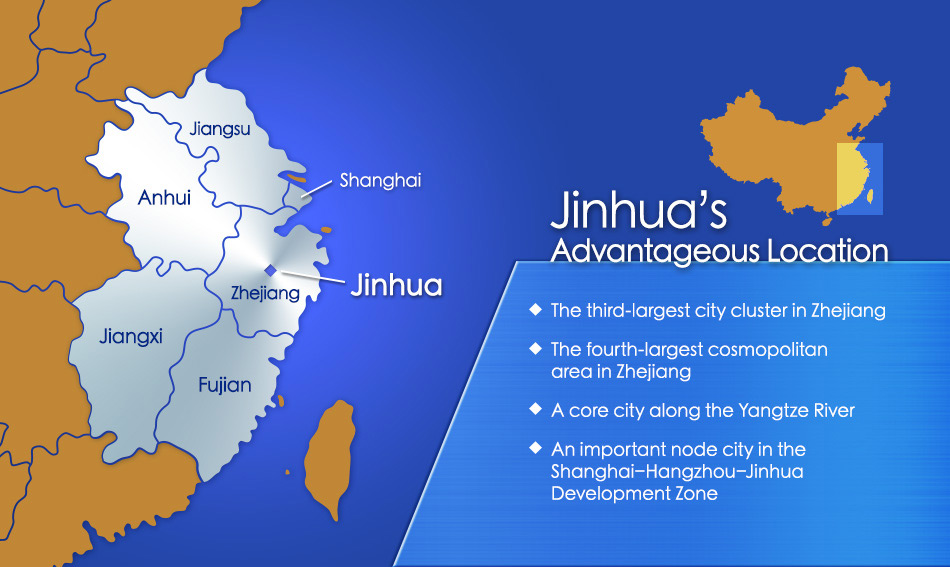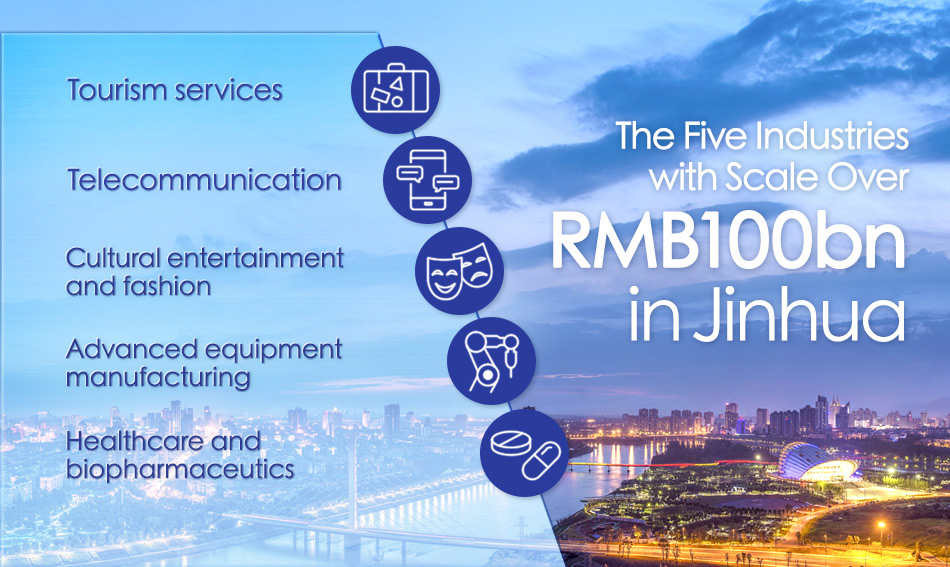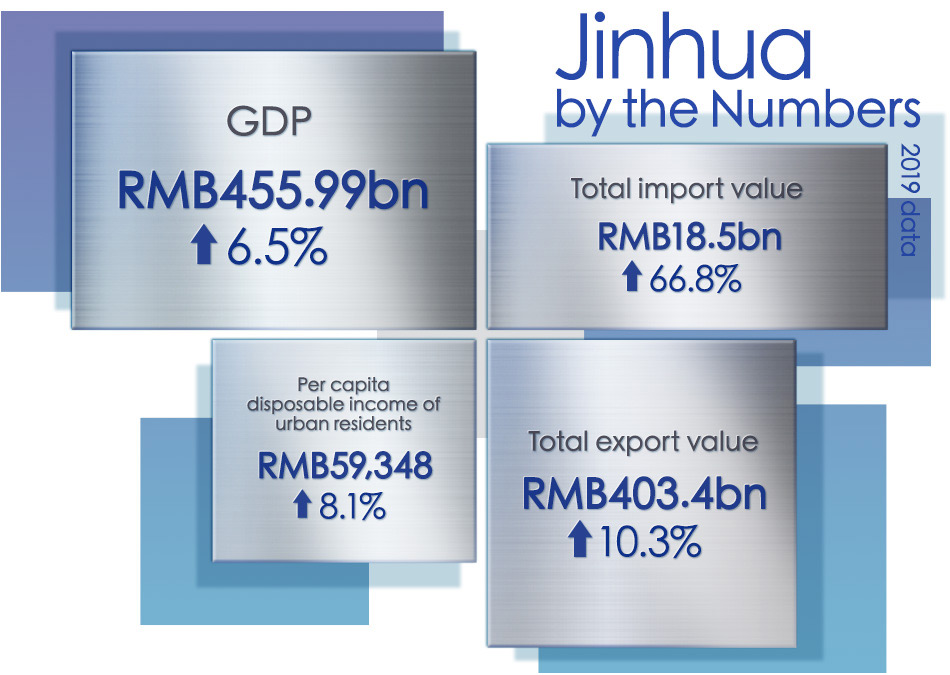Jinhua, located in the middle of Zhejiang Province in Mainland China, offers a considerable number of advantages to businesses and investors, including its prime location, rich natural resources, highly developed manufacturing industries and vast market reach
Jinhua is located on the southern wing of the Yangtze River Delta Economic Circle in the central part of Zhejiang Province, lying next to Wujiang River. Covering an area of 11,000 square kilometres, the city administers four county-level cities (Lanxi, Dongyang, Yiwu and Yongkang), three counties (Pujiang, Wuyi, Panan) and two districts (Wucheng and Jindong), and is home to 5.564 million people.Jinhua is known as “a land of long history and rich culture”, a place where celebrities gather, a city of literary prosperity and home of beautiful mountains and rivers. It is also one of the 26 core cities under a plan to build a cluster of cities along the Yangtze River that will be the third-largest city cluster and the fourth-largest cosmopolitan area in the province. Construction is also underway that will make it an important node city in the Shanghai−Hangzhou−Jinhua Development Zone.
In 2019, the city registered a GDP of RMB455.99bn, representing 6.5 per cent increase from the previous year, while its general public budgeted revenue stood at RMB41.13bn, an increase of 4.8 per cent. Moreover, per capita disposable income of urban and rural residents increased 8.1 per cent and 8.7 per cent, respectively, to RMB59,348 and RMB28,511.

Geographical advantages
Jinhua has long been a transportation hub with operations of Zhejiang−Hunan Railway, Jinhua−Wenzhou Railway and Jinhua−Quindaowu Railway, Hangzhou−Changsha High-speed Railway, and Jinhua−Wenzhou New Railway. More than 200 high-speed trains pass through or terminate service at Jinhua daily. It takes 100 minutes to travel from Jinhua to Shanghai and 40 minutes only to Hangzhou. In 2019, the Madrid−Yiwu train operated 528 freights, representing a growth of 65 per cent, the Jinhua−Central Asia Train ran 103 freights, a growth of 84 per cent, and the Yiwu−Ningbo-Zhoushan sea-rail combined transportation shipped 110,000 TEUs, a growth of 25 per cent. Moreover, there are five high-speed and standard railways under construction, namely the Jinhua−Yiwu−Dongcheng intercity rail, the Jinhua−Taizhou, Jinhua−Ninbo, Jinhua−Jiande, and Hangzhou−Wenzhou Railway. Additionally, five highways, including Linan−Jinhua, Yiwu−Dongyang−Yongkang, and Hangzhou−Shaoxing−Jinhua−Taizhou, and five intercity expressways, including Jinhua−Lanxi, Jinhua−Yiwu and Jinhua−Wuyi are being constructed.Yiwu Airport has launched direct flights to more than 20 cities, including Hong Kong and Bangkok, as well as five daily flights to Guangzhou.
Dongyang−Hengdian−Tongyong Airport is also ready to operate. Jinhua is also the second-largest information exchange hub in Zhejiang Province, with two national-level first class and 10 national-level second class optical fibre cables passing through the city.

Sound system and strong base
Jinhua is a veritable “large market of markets”. There are 91 markets with an annual turnover of over RMB100m and five markets with over RMB10bn. Among them, Yiwu China Small Commodities City and Yongkang China Science and Technology Hardware City are well-known at home and abroad. With a sound system, the city has established trade relations with 221 countries and regions all over the world, of which 71 countries and regions registered export trade value exceeding RMB1bn. It is no wonder that Jinhua is rated as the most dynamic city in Mainland China’s Belt and Road Initiative. In 2019, total export value reached RMB403.4bn, an increase of 10.3 per cent, and import value recorded RMB18.5bn, an increase of 66.8 per cent − a growth rate that ranked first in the province. Jinhua exported RMB172.85bn of goods to countries along the Belt and Road region, a year-on-year increase of 10 per cent and accounted for 42.9 per cent of the city’s exports. The city’s export volume ranks first in the province.Jinhua enjoys the reputation of being “the hometown of hundreds of handicrafts”. It has a favourable industrial foundation and is undergoing rapid development. The total trade value of specialised markets registered RMB323.2bn per annum, among which five markets recorded annual turnover of more than RMB10bn. The small commodities wholesale market in Yiwu is the largest in the world, while the world’s third-largest metal products trading centre is in Yongkang.

The grand market consists more than one million enterprises, ranking third in scale in the province and accounts for 15 per cent of the province’s total. The private sector is responsible for 91 per cent of the city’s GDP and 86 per cent of its fiscal tax income. Telecommunication, advanced equipment manufacturing, health care and biopharmaceutics, cultural entertainment and fashion, and tourism services are the five industries with scale over RMB100bn each and are developing rapidly. There are also 16 industrial clusters with an annual production over RMB10bn. Jinhua has been awarded more than 20 titles related to its status as a national-level industrial base, including “China’s Mobile and Motor Accessories Industry Base” and “China Hardware’s Manufacturing and Export Base”.
Robust clusters
Jinhua has successively won the titles of “National Historic and Cultural City”, “China’s Excellent Tourism City”, “National Hygiene City”, “National Garden City”, “National Forest City”, “National Model City for Civilian and Army Welfare”, and “China’s Top Ten Most Liveable Cities”. The nine counties and districts under its administration each have their own characteristics. Among them, Yiwu is known as the world’s largest small commodity market and Dongyang is a famous film and television tourism city and a hometown of Chinese architecture. While Yongkang is an international city for hardware, Lanxi is famous for its Chinese weaving, Pujiang is a hometown of Chinese calligraphy and painting and crystals, Wuyi is a famous hot spring spa city, and Panan is a national key ecological function zone. Yiwu, Dongyang and Yongkang have been ranked among the top 100 counties (cities) in the country for years.Construction on two comprehensive traffic corridors, the Jinhua-Yiwu Science and Technology Corridor and the Central Zhejiang Ecological Corridor, have been accelerated. With a total investment of over RMB34bn, the Jinhu−Yiwu−Dongyang Rail Transit Project is going full speed ahead, and a pilot section has been completed ahead of schedule. With concerted efforts and quickened progress, an integrated cities cluster in central Zhejiang will soon emerge.
Exquisite environment and abundant tourism resources
Jinhua is gifted with a beautiful scenery and an excellent ecological environment. The city’s forest coverage rate is well over 61 per cent, and it has the best category I drinking water in the province. Its air quality improvement rate in urban area is second-highest in the province, and its beauty index keeps improving. It now has five national scenic spots, one national 5A-level tourist zone, 20 national 4A-level tourist zones, five provincial-level scenic spots and seven provincial-level tourist resorts. Moreover, an imperial residence of the Taiping Heavenly Kingdom, Double Dragon Cave, Hengdian Film City and Lanxi Labyrinth Village are well-known and popular tourist attractions.In 2019, the city welcomed a total of 140 million tourists, an increase of 15.7 per cent from the previous year, and registered a tourism revenue of RMB157.97bn, an increase of 16.9 per cent. Domestic tourists amounted to 139 million, an increase of 15.8 per cent, and domestic tourism revenue was recorded at RMB154.301bn, an increase of 17.1 per cent. In addition, there were 889,300 foreign tourists, an increase of 5.5 per cent, and the foreign exchange revenue from tourism was US$532m, an increase of 6.2 per cent.

Major foreign investment platforms
1. Jinhua Economic and Technological Development ZoneThe zone was established in 1992 as a national-level economic and technological development zone. It is composed of two sectors, Jiangnan Sector and Jinxi Sector, and has been awarded many titles, such as the National Sci-tech Innovation Demonstration Base for Youths, the Most Competitive Pioneering Park in Eastern China, the Zhejiang Base of New Energy Vehicle Industry for Foreign Investment, and the Zhejiang Electronic Information Industry Base. Two industry clusters each valued at RMB10bn have been established — the vehicle and spare parts industry and the electronic information industry. The biological medicine, new materials, energy conservation and environmental protection industries have also been developed.
2. Jin-Yi Comprehensive Bonded Zone
The zone covers a planned area of 1.79 square kilometres and commenced operation in June 2017, accommodating more than 40 registered enterprises. The Comprehensive Bonded Zone is located at the core cosmopolitan area within 20 kilometres from Jinhua and Yiwu. It is divided into five functional sectors: the port operation area, the bonded processing zone, the bonded logistics area, the international trade zone and the comprehensive services area. The zone has become a new platform for serving the Four-province and Nine-city Economic Co-operation Area and aligning with the national development strategy of the Belt and Road Initiative.
3. Jinhua Mountain Tourist and Economic Area
Rich in natural and cultural resources, the area has a number of scenic locations, such as Double Dragon Scenic Spot, National Forest Park, Temple of the Great Immortal Huang, Jinlin Bergamot Garden and Temple of the Wiseman.
4. Duohu Central Business District
The district is located at the “first ring” of Jinhua at the confluence of three rivers and covers an area of 6.78 square kilometres. It encompasses five main centres consisting of a headquarters economic centre in central Zhejiang, a technological and cultural centre in Jinhua, a regional financial service centre, an urban business and innovation centre, and an urban ecological recreation centre. Among them, the planned area for the economic centre for headquarters is approximately 320mu. There are plans to establish a high-end business centre integrating a 5A office building, a five-star hotel, an educational training area, a cultural creativity area, and catering, leisure and entertainment facilities.

